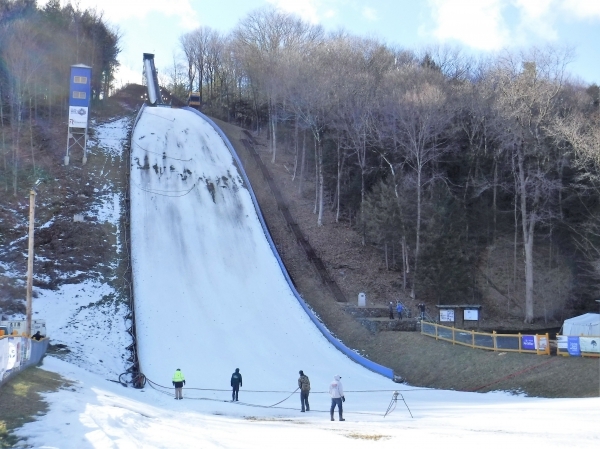BRATTLEBORO — The national television crew arrived at the Harris Hill Ski Jump this Presidents' Day weekend with plans to capture all the pageantry and pyrotechnics of a high-flying centennial celebration for Vermont's lone Olympic-size venue.
Instead, it witnessed something more head-spinning.
As historians tell it, the landmark sprung 100 years ago when local sports pioneer Fred Harris eyed an evergreen-laden hill and led workers in clearing trees, crushing rock and cobbling together a launchpad for a 1922 inaugural competition that drew a crowd of 2,500 people.
Miraculously, conception to completion took only a month. But that was an eternity compared to the single night Harris's successors faced to ready the 30-stories-tall jump this past weekend.
Groomers had smoothed over the frozen slope Wednesday, only to see a freak 60-degree thaw and pelting, melting rain strip much of it away Thursday.
That forced organizers to cancel Friday's scheduled fireworks and call in snowmaking guns in a last-minute attempt to save the rest of the centennial.
Friday-night travelers exiting Interstate 91 for southern Vermont resorts like Stratton drove past the surreal sight of a hill lit as brightly as Times Square teeming with crew members, athletes, and coaches raking, shoveling, and foot-stomping the slope.
“Like the olden days,” said Todd Einig, who first jumped Harris Hill in 1986 before becoming its current head of competition. “This is what it's all about. When the challenges hit, everyone comes together.”
Spencer Knickerbocker, the first athlete to test the jump after its $600,000 renovation in 2009, used his skis to tamp down manmade snow and his own sense of discouragement.
“An hour in, I started feeling we could achieve this,” the 29-year-old Marlboro resident said. “It's a lot better than we thought it would be.”
By the time the sun rose Saturday, the hill was set. That's when, moments after a crowd of thousands cheered a training run, flakes began falling from the sky.
Hard.
Vermont announcer Peter Graves, who chose the centennial over working at the Olympics as he has since 1980, said organizers would wait a half hour to see if the squall would pass. When it didn't, Graves asked everyone to hold tight, as the ground had morphed from a mud bath into a skating rink.
Jumping finally began two hours after its scheduled start, bringing together more than 40 athletes from as far west as Alaska and as far east as Iceland, Norway, and Slovenia.
Up close and personal
“I always want to come back,” said Chris Lamb, a 32-year-old Marlboro College graduate who flew in from Oregon.
The crowd, for its part, came to see one of the few natural jumping hills where, in a world of scaffolding and security, you can meet athletes up close.
Take 10-year-old Charley Grandinetti of Massachusetts, who approached Knickerbocker - billed by the public address system as a “hometown hero” - in 2019.
“I said we were fans,” the boy recalled.
The jumper, who had just won a medal, gave it to Grandinetti, who wore it when he returned this past weekend.
Event honors former athletes
Sunday's final round of competition featured a reunion of some 60 former athletes as senior as 91-year-old Addison Minott of Guilford and as celebrated as fellow Vermonter Bill Koch, 66, the first American to win a Nordic Olympic medal.
The event also exhibited the six Winged Ski trophies awarded to three-time winners, ranging from the first cup Harris commissioned from the famed jeweler Cartier to the latest his daughter, Sandy, recently had crafted from local glass, wood, and marble.
With his win over the weekend, 20-year-old Ole Kristian Baarset of the 1994 Olympic home of Lillehammer, Norway, joined the century-long list of champions.
“This is my first time in America,” Baarset said. “This jump reminds me of some of our favorite hills at home. I really love it.”
'Producing snow from almost nowhere'
This year's jump itself echoed back to 1938, when organizers without snow trucked in tons days before they were set to host the national championship, only to find the competition hit by surprise flurries.
That year, the Brattleboro Reformer called the event “a day of triumph” for those who “had a part in producing snow from almost nowhere.”
Fast forwarding to the present, Brattleboro resident Hugh Barber, the only Vermont athlete to retire the Winged Ski Trophy, watched the seeming 1938 replay with amazement.
“Wednesday it was 8 degrees, Thursday it was 60,” Barber said. “This weekend, we've seen a little bit of everything.”
Jason Evans, a local contractor in charge of hill preparation, stood by with a smile.
Said the less-talk, more-action Vermonter: “Just another day.”
